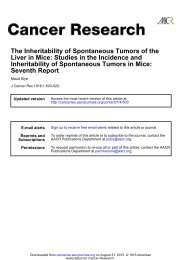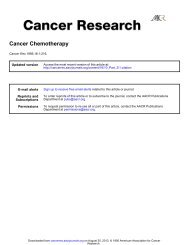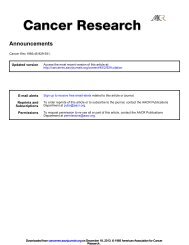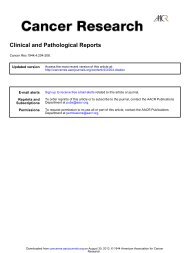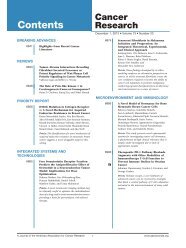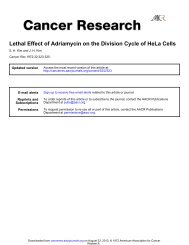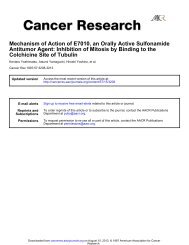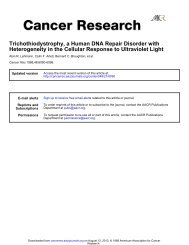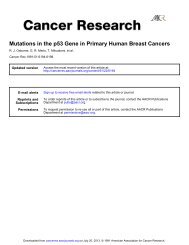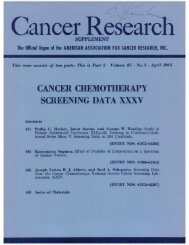Isolation and Characterization of a Hepatoma ... - Cancer Research
Isolation and Characterization of a Hepatoma ... - Cancer Research
Isolation and Characterization of a Hepatoma ... - Cancer Research
You also want an ePaper? Increase the reach of your titles
YUMPU automatically turns print PDFs into web optimized ePapers that Google loves.
CHARACTERIZATION OF A HEPATOMA ABNORMAL PROTHROMBIN<br />
ity was assayed by measuring the acceleration <strong>of</strong> the clotting <strong>of</strong> prothrombin-deficient<br />
plasma using Stypven to initiate coagulation (9).<br />
The activation <strong>of</strong> prothrombin <strong>and</strong> HAPT to thrombin in the absence<br />
<strong>of</strong> calcium was performed using the Echis carinólas venom assay (7).<br />
Protein concentrations <strong>of</strong> prothrombin <strong>and</strong> HAPT were determined<br />
spectrophotometrically at 280 nm using an E^,inm„m<strong>of</strong> 14.4 (16).<br />
Analytical Electrophoresis. Polyacrylamide gel electrophoresis in the<br />
presence <strong>of</strong> dodecyl sulfate was performed on prothrombin, abnormal<br />
prothrombin, <strong>and</strong> HAPT using 10% acrylamide gels (18). Proteins were<br />
reduced using 2-mercaptoethanol. Electrophoretic analysis <strong>of</strong> the het<br />
erogeneity <strong>of</strong> the partially carboxylated prothrombin species in the<br />
HAPT was performed using 1251 radiolabeled proteins <strong>and</strong> disc gel<br />
electrophoresis (19) in the presence <strong>of</strong> 8 mM CaC12 as described by<br />
Borowski (17). Native prothrombin, abnormal prothrombin, <strong>and</strong><br />
HAPT were radiolabeled with Nal251 by the lactoperoxidase method<br />
(20). Electrophoresis was performed on the tube gels with a 7.6%<br />
acrylamide, 0.3% bisacrylamide resolving gel <strong>and</strong> a 1.8% acrylamide-<br />
0.22% bisacrylamide stacking gel. Gels, buffers, <strong>and</strong> samples were made<br />
8 mM in CaCl2. After electrophoresis the gels were sliced into 1-mm<br />
fragments <strong>and</strong> counted for 1251 in a Beckman Gamma 8000 scintilla<br />
tion spectrometer.<br />
Ammo-terminal Sequence <strong>and</strong> Amino Acid Analysis. The amino<br />
terminal sequence <strong>of</strong> HAPT was determined by automated Edman<br />
degradation using a Beckman 8900 spinning cut sequenator equipped<br />
with a cold trap. The phenylthiohydantoin derivatives were analyzed<br />
on a Waters HPLC using a Waters C18-/iBondapak column with an<br />
ethanol gradient in ammonium acetate, pH 5.1 (21).<br />
Amino acid analysis was performed on a Beckman model 119CL<br />
amino acid analyzer equipped with a Beckman model 126 data system.<br />
Proteins were hydrolyzed in 6 MHC1 at 110°Cfor 24 h. For quantitation<br />
<strong>of</strong> Gla, the proteins were hydrolyzed in 2 M KOH for 22 h at 110°C<br />
(17, 22). The Gla composition was quantitated after alkaline hydrolysis<br />
by HPLC using a fluorescence detection procedure (17, 22).<br />
Lectin Blotting Studies. A comparison <strong>of</strong> the level <strong>of</strong> glycosylation <strong>of</strong><br />
HAPT <strong>and</strong> NPT was performed by the binding <strong>of</strong> 1251-labeled concanavalin<br />
A to these proteins immobilized on nitrocellulose paper.<br />
Serial dilutions <strong>of</strong> HAPT <strong>and</strong> NPT in TBS were applied to the nitro<br />
cellulose paper. The paper was then incubated for l h in 3% bovine<br />
serum albumin in TBS. After the blot was washed 4 times with TBS, it<br />
was incubated for 3 h at 37°Cwith '25I-labeled concanavalin A in 3%<br />
bovine serum albumin-TBS. The blot was then washed 5 times in TBS,<br />
dried, <strong>and</strong> exposed to Kodak X-O mat R Film for 2-6 days. Quantita<br />
tion <strong>of</strong> the binding <strong>of</strong> the concanavalin A was performed by densitometric<br />
scanning <strong>of</strong> the autoradiographs using an EDC densitometer<br />
(Helena Laboratories).<br />
RESULTS<br />
Purification <strong>of</strong> HAPT. HAPT was purified from the ascites<br />
fluid <strong>of</strong> a patient with widely disseminated hepatocellular car<br />
cinoma. Approximately 2.8 liters <strong>of</strong> ascitic fluid were used for<br />
the isolation <strong>of</strong> HAPT. The patient had markedly elevated<br />
blood levels <strong>of</strong> HAPT <strong>and</strong> had previously been reported (Ref.<br />
10; Table 2, Patient 3). Listed in Table 1 are the concentrations<br />
<strong>of</strong> NPT <strong>and</strong> HAPT in the blood <strong>and</strong> ascites fluid <strong>of</strong> this patient<br />
as measured by radioimmunoassay. The ascites fluid concentra<br />
tion <strong>of</strong> HAPT was equivalent to the levels found in the patient's<br />
blood, while NPT was only 35% <strong>of</strong> the blood levels. After<br />
purification, 4.2 mg <strong>of</strong> HAPT were obtained from the ascites<br />
fluid. This was a final preparative yield <strong>of</strong> 38% <strong>of</strong> the estimated<br />
total concentration <strong>of</strong> HAPT in the ascites fluid (Table 1).<br />
The concentrations <strong>of</strong> total prothrombin antigen, native pro<br />
thrombin antigen, <strong>and</strong> abnormal prothrombin antigen were<br />
measured in the purified HAPT preparation by competition<br />
radioimmunoassays (Table 2). The concentrations <strong>of</strong> these an<br />
tigens were compared with the estimated concentration <strong>of</strong><br />
HAPT as determined spectroscopically. Approximately 92% <strong>of</strong><br />
the purified HAPT competed with NPT in the radioimmuno-<br />
Table 1 Purification <strong>of</strong> hepawma-associated abnormal prothrombin<br />
AmountSerum<br />
(//g/ml")<br />
NPT (Kg/ml0)<br />
Ug/ml")Ascites<br />
HAPT<br />
NPT (Mg/nila)<br />
HAPT („g/ml")<br />
(liters)Total Volume<br />
HAPT (mg)<br />
Isolated HAPT (mg*)<br />
HAPT yield ("¿)603.921<br />
°Determined by competition radioimmunoassay.<br />
* Determined spectroscopically.<br />
3.8810.864.2<br />
Table 2 Immunochemical characterisation <strong>of</strong> purified HAPT<br />
HAPT"<br />
TPT*NPT*<br />
APT*Concentration<br />
(jig/ml)640<br />
588<br />
11<br />
511%<br />
38<br />
<strong>of</strong>HAPT100<br />
92<br />
2<br />
80<br />
*Concentration determined spectroscopically.<br />
*Concentration determined by competition radioimmunoassay.<br />
assay for total prothrombin antigen. The native prothrombin<br />
antigen was measured in the HAPT preparation using the antiprothrombin:Ca(II)<br />
antibodies. Anti-prothrombin:Ca(ll) anti<br />
bodies bind only fully carboxylated native prothrombin species<br />
capable <strong>of</strong> undergoing a metal-induced conformational transi<br />
tion. Less than 2% <strong>of</strong> the purified HAPT competed with NPT<br />
in the radioimmunoassay for native prothrombin antigen. Antiabnormal<br />
prothrombin antibodies bind abnormal prothrombin<br />
but not fully carboxylated native prothrombin (9). In the com<br />
petition radioimmunoassay for abnormal prothrombin antigen,<br />
80% <strong>of</strong> the HAPT competed with APT. Approximately 10%<br />
<strong>of</strong> HAPT as measured by the immunoassay for total prothrom<br />
bin antigen failed to bind to either the anti-prothrombin:Ca(II)<br />
or anti-abnormal prothrombin antibodies suggesting the pres<br />
ence <strong>of</strong> a population <strong>of</strong> partially carboxylated prothrombin<br />
species (17).<br />
Structural <strong>Characterization</strong> <strong>of</strong> HAPT. The isolated HAPT<br />
was studied by dodecyl sulfate-gel electrophoresis. The protein<br />
appeared >95% pure <strong>and</strong> migrated as a single b<strong>and</strong> in the<br />
presence <strong>of</strong> 2-mercaptoethanol with the same mobility as NPT<br />
(Fig. 1). The amino-terminal sequence <strong>of</strong> the HAPT was com<br />
pared to that <strong>of</strong> NPT in order to determine whether the varia<br />
tion in Gla content could be attributed to differences in the<br />
primary structure <strong>of</strong> this region. The first 14 amino acid resi<br />
dues <strong>of</strong> the HAPT were identical to those <strong>of</strong> NPT <strong>and</strong> the<br />
published known sequence <strong>of</strong> prothrombin. These results indi<br />
cate that there are no differences in the amino-terminal se<br />
quences <strong>of</strong> HAPT <strong>and</strong> NPT between residues 1 <strong>and</strong> 14, nor<br />
does HAPT possess an unprocessed leader sequence similar to<br />
Factor IX Cambridge (23). However, I cannot exclude the<br />
possibility <strong>of</strong> a mutation involving other Gla residues at posi<br />
tions 16, 19, 20, 25, 26, <strong>and</strong> 32 <strong>of</strong> the prothrombin aminoterminal<br />
region. Specific identification <strong>of</strong> Gla content in NPT<br />
<strong>and</strong> HAPT cannot be obtained by this technique since the<br />
formation <strong>of</strong> the phenylthiohydantoin derivative <strong>of</strong> Gla results<br />
in its conversion into phenylthiohydantoylglutamic acid.<br />
The amino acid composition <strong>of</strong> the acid hydrolysate <strong>of</strong> HAPT<br />
showed no significant difference from NPT. The Gla compo<br />
sition was quantitated after alkaline hydrolysis by HPLC <strong>and</strong><br />
fluorescence detection. The Gla content for NPT, APT, <strong>and</strong><br />
HAPT is presented in Table 3. These results indicate that<br />
6494<br />
Downloaded from<br />
cancerres.aacrjournals.org on July 30, 2013. © 1989 American Association for <strong>Cancer</strong> <strong>Research</strong>.




